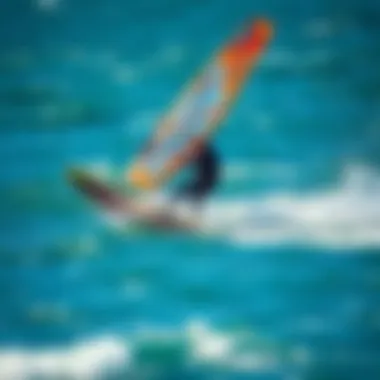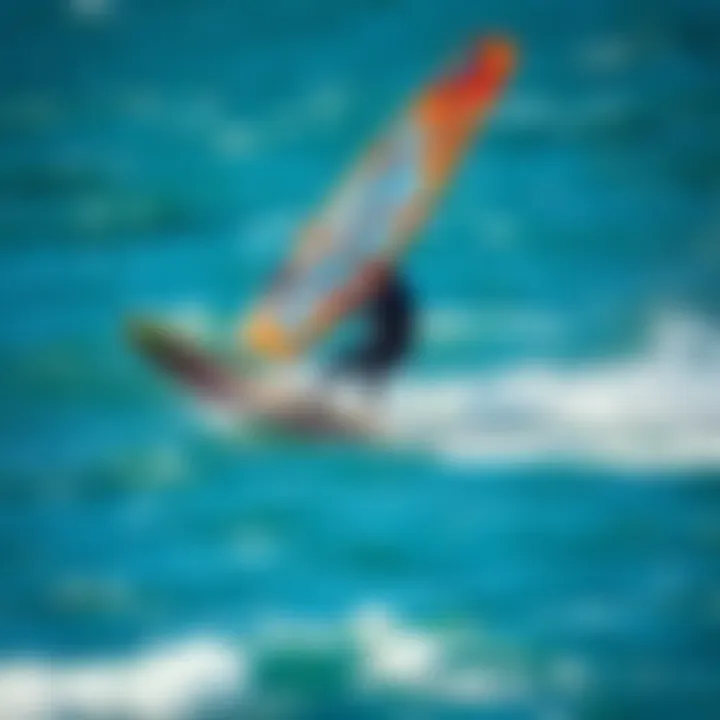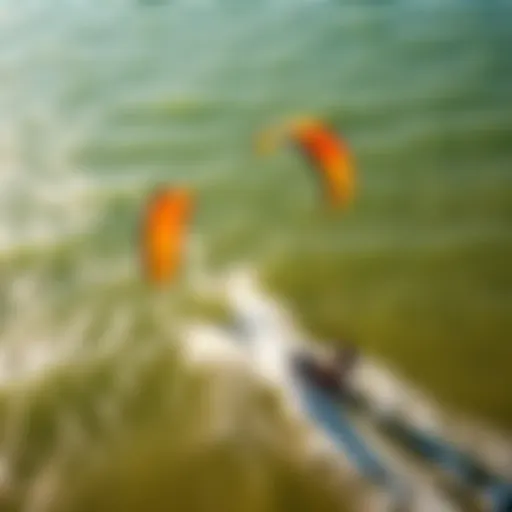Mastering Windsurfing Weather: Essential Insights for Riders


Intro
When it comes to windsurfing, the weather is your best friend and your worst enemy. For enthusiasts who revel in the thrill of gliding over water, understanding the meteorological conditions can make all difference. Winds and waves can change by the minute, and without a firm grasp of what’s swirling in the skies above, one could find themselves either sailing smoothly or battling nature’s unyielding elements.
In this comprehensive guide, we’ll dive deep into the various weather factors that influence windsurfing performance. From the shifting winds to the unpredictable clouds, our focus is to equip riders with essential knowledge that enhances not only their safety but also their overall enjoyment of the sport.
Let’s explore the art of reading the weather, from identifying the ideal conditions for your next ride to skillfully navigating the occasional storm that may arise. The wind doesn’t wait for anyone, and every minute spent on the water is a chance to catch the perfect breeze or learn how to adapt when nature throws a curveball. By arming yourself with information, you can elevate your windsurfing skills and truly master the elements.”
Gear Selection
Understanding the perfect gear for your windsurfing adventure is crucial. By selecting the right kite, board, and accessories, you can navigate the water with greater ease and adapt to shifting weather patterns.
Types of Kites
Windsurfing kites come in various shapes and sizes, each serving its purpose based on the wind conditions you might encounter. Here are a few different types to consider:
- Inflatable Kites: Great for beginners, these kites offer stability and are easy to control.
- Foil Kites: As the name suggests, these have a unique design that allows them to perform better in lighter winds.
- C-Kites: These provide powerful lift and require more skill to handle; best suited for advanced riders.
Understanding which kite to pick based on wind conditions can significantly enhance your experience. Check out discussions on platforms like reddit.com for personal experiences shared by other windsurfers.
Choosing the Right Board
When it comes to selecting a board, think about your weight and the type of conditions you plan to surf in.
- Freestyle Boards: Lightweight and designed for tricks and jumps, these boards are made for calm weather.
- Wave Boards: Ideal for rough waters, these sturdy boards can handle stronger winds.
- Freeride Boards: A jack-of-all-trades, these are good for various conditions and provide a balance of speed and maneuverability.
In the world of windsurfing, each piece of gear can amplify your connection to the wind and water. Engaging with local communities can further refine your choices, providing valuable insights and direct recommendations that suit your specific skill level.
“The right gear won’t just keep you safe. It’ll help you connect, explore, and truly enjoy the exhilarating dance of wind and waves.”
End
With the right knowledge of weather patterns and gear selection, the sky truly is the limit for what you can achieve in the world of windsurfing. Here’s to new heights and thrilling rides—you’re now ready to understand winds with confidence!
Prologue to Windsurfing and Weather
Understanding the relationship between windsurfing and weather is more than just a matter of curiosity for enthusiasts; it can be a matter of safety and performance. Wind, waves, and temperature—these elements directly impact how a rider navigates the water. A novice might simply look for a day with decent wind, while seasoned windsurfers know that the subtle shifts in weather can define their experience entirely.
Being attuned to weather conditions can give one the edge, allowing for not just better performance but also enhanced safety during activities. Think about this: a beautiful sunny day might suggest perfect conditions, but lurking clouds might signal approaching wind shifts or storms. Knowledge of weather can help you make informed choices about when to sail or when to stay ashore.
Furthermore, understanding weather terminology is crucial. Words like "gust" and "lull" carry weight in the windsurfing community. Those who grasp these terms can read the water better and plan their sessions wisely. So, diving into the interplay of windsurfing with weather conditions helps foster a culture of awareness. It creates a community of informed riders who prioritize safety and optimal performance. In the idea of teamwork amongst windsurfers, just as a sailor depends on the wind, they must also depend on the weather's predictability.
As we explore this guide, we aim to shed light on various meteorological factors and how they affect windsurfing, while also equipping you with the tools needed to monitor and interpret weather conditions effectively.
Essential Weather Terminology
Understanding the right terminology is key for any windsurfer. It’s like learning the lingo before stepping into a foreign land; without it, you’re bound to get lost. Comprehending essential weather terms allows enthusiasts to assess conditions accurately and make informed decisions, ensuring both safety and enjoyment.
Understanding Wind Speed and Direction
Wind speed and direction are the lifeblood of windsurfing. Knowing how fast and from which way the wind is blowing can make the difference between a thrilling ride and a challenging day on the water.
Wind speed is measured in knots, and it plays a critical role in boat performance. For instance, a wind speed of 10 to 15 knots is often considered ideal for novice windsurfers, giving them a good balance of lift and maneuverability. Meanwhile, advanced riders might prefer 20 knots or more, which can challenge their skills and lead to exhilarating experiences.
Wind direction, on the other hand, indicates where the wind is coming from. This is described using cardinal points: North, South, East, and West. A downwind course, for example, is when a windsurfer is sailing in the same direction as the wind. Conversely, upwind is navigating against the wind, demanding a higher skill level and technique.


A good visual representation of wind direction can be found in wind roses. These diagrams show the frequency of winds coming from various directions, helping windsurfers plan their routes more efficiently. By knowing both wind speed and direction, riders can gauge whether their intended location is conducive for a successful day of windsurfing.
"Wind is the one constant in windsurfing; know its mind, and you can ride the waves like a pro."
Deciphering Weather Patterns
Weather patterns aren’t just for meteorologists; they’re crucial for anyone venturing out on the water. Being able to analyze weather systems can help windsurfers avoid treacherous conditions while maximizing their time on the water.
A basic understanding of high-pressure systems versus low-pressure systems can aid in prediction. High pressure typically brings stable and calm conditions, which can enhance performance for recreational windsurfing. Conversely, low-pressure areas often signal stormy weather, marked by squall lines and sudden gusts that could endanger even the most seasoned windsurfers.
Other meteorological terms, like fronts, play an important role as well. A cold front can lead to sharp temperature drops and increased wind speed. This change can be sudden, creating unpredictable and potentially dangerous conditions on the water.
Additionally, meteorologists often use Doppler radar and satellite imagery to track storms and changes in weather, giving windsurfers a heads up on potentially hazardous conditions. Folowing local news channels and weather apps can keep riders informed about impending weather changes that could affect their plans.
To fully grasp these concepts, consider checking resources like NOAA.gov for detailed information on weather forecasts specific to your area. Knowing how to interpret the signs of weather can often differentiate between an enjoyable day on the waves and a trip marred by unfavorable conditions.
Meteorological Factors Affecting Windsurfing
Understanding the meteorological factors affecting windsurfing is vital for any enthusiast looking to enhance their performance and safety on the water. Weather isn’t just background noise; it’s a key player that can make or break a session. Windsurfers have to stay sharp, knowing how different elements like wind, temperature, and cloud cover come into play. This knowledge not only influences planning but can also save lives.
Wind: The Core Element of Windsurfing
Wind is the lifeblood of windsurfing. Without it, the sport simply wouldn’t exist. When considering wind, there are a couple of critical aspects to keep in mind:
- Speed: Usually measured in knots, understanding wind speed helps you gauge the intensity of conditions you'll be facing.
- Direction: Knowing where the wind is coming from can drastically change your strategy. Cross-shore, on-shore, or off-shore winds each present unique challenges.
The ideal wind for most windsurfers sits between 10 to 25 knots. If it’s too light, your board feels sluggish. If it’s too strong, it could turn into a wild ride you didn’t sign up for. Monitoring your local conditions through reliable forecasts is essential for planning your day on the water.
Temperature and Its Impact on Performance
Temperature isn't just about comfort; it affects your performance as well. Warm air can cause the wind to become unstable and shift unpredictably. This can throw a wrench into your tactics if you aren’t prepared. Here are some considerations regarding temperature:
- Warm Temperatures: They tend to create thermal breezes, especially in coastal areas. These breezes can provide consistent wind patterns, perfect for a fun-filled day.
- Cold Temperatures: Riding in chilly weather often requires a more nuanced approach. The wind can feel stronger, affecting your balance and technique. Proper gear, like wetsuits or dry suits, becomes crucial to keep the body temperature regulated while navigating the waters.
Getting used to how different temperatures interact with your skills and equipment could help you avoid surprises that lead to falls.
Cloud Cover and Visibility Considerations
Cloud cover is something that newcomers might overlook, but it has a significant impact on visibility and wind patterns. Here are some factors to consider:
- Overcast Skies: They can lead to shifts in temperature and wind patterns, resulting in unpredictable gusts.
- Clear Skies: Often associated with stable winds. However, as the sun rises and sets, you might encounter thermal changes affecting conditions.
Visibility is crucial, especially if you’re out during twilight hours or foggy conditions. Always be aware of your surroundings, and consider the potential changes in weather as you ride.
"Understanding these fundamental meteorological aspects aids in creating a safer and more enjoyable experience on the water. A small missed detail can unhinge everything."
Gearing up for a windsurfing session means more than just enjoying the ride; it demands close attention to the atmosphere around you. Whether that means following localized forecasts or simply gauging the wind’s temperament while out on the water, your safety and success in windsurfing relies heavily on these meteorological factors.
Monitoring Weather Conditions
Monitoring weather conditions plays a pivotal role in enhancing the windsurfing experience. By staying attuned to the weather, enthusiasts can make smarter choices that not only elevate their enjoyment of the sport but also ensure their safety on the water. Understanding how to interpret changing conditions enables windsurfers to optimize their sessions, adapt to challenges, and ultimately, improve their skill level.
Using Weather Apps and Tools
In this digital age, weather apps and tools are indispensable for any windsurfing aficionado. These apps provide real-time data on wind speed, direction, temperature, and more—all essential for planning a successful outing. For instance, Windy and AccuWeather offer comprehensive forecasts that can enable a windsurfer to gauge the most favorable times to hit the water.


- Why are weather apps essential?
- They deliver timely updates for shifting conditions.
- They can predict reliable wind patterns.
- Users can access localized data, which is crucial for specific spots.
Imagine planning a day out, only to find yourself facing strong gusts that could have been avoided had you consulted your app. This could lead to a precarious situation on the water. In certain apps, users can even set alerts for changes in wind conditions. This feature can greatly assist windsurfers who may be preoccupied with setting up their equipment, allowing them to remain informed on critical changes.
Interpreting Forecasts Effectively
Reading a weather forecast accurately is a skill in itself, one that can separate an average windsurfer from a skilled one. The best way to tackle forecasts is to hone in on specific details and not take the summaries at face value. Here are some crucial elements to consider:
- Wind Speed and Gusts: Not all wind is created equal. Wind speeds can fluctuate significantly, especially in coastal areas where terrain can create unpredictable gusts. Understanding how to distinguish between sustained wind speeds and gusts can affect your ability to maneuver.
- Wind Direction: It's not just about how strong the winds are but also where they’re coming from. Apprehending this will impact your trajectory across the water. A wind from the south might present different challenges than one from the northwest.
- Temperature Changes: Shifts in temperature often precede changes in other weather conditions. A sudden drop might suggest an impending storm, signaling an opportunity to pack up instead of hitting the waves.
Effective interpretation of weather forecasts goes beyond mere readings. Engaging with local windsurfing communities online, like on platforms such as reddit.com or through specialized windsurfing forums, can provide atypical insights and practical advice from experienced windsurfers. Keeping abreast of seasonal variations can also give context to forecasts, highlighting why certain periods yield better wind conditions.
"A gusty wind might seem like a thrill, but knowledge is the true sail that catches the wind."
Optimal Weather Conditions for Windsurfing
When it comes to windsurfing, the adage "better safe than sorry" rings especially true. Choosing the right weather conditions can significantly influence not just performance, but safety and enjoyment. A windsurfer's experience is tied deeply to these elements; thus, understanding optimal weather conditions is critical.
Identifying Ideal Wind Conditions
Wind is the lifeblood of windsurfing. Without it, you're just a person perched awkwardly atop a board with a sail flopping about like a wet blanket. But what truly defines "ideal" wind conditions? Generally, steady winds of 10 to 25 knots are often favored. This range provides enough push without causing the equipment to become unwieldy or excessively challenging for the rider.
Several factors determine whether wind is ideal:
- Consistency: Gusty winds can lead to erratic sailing experiences. Lack of wind uniformity might leave a rider struggling or, conversely, finding themselves uncontrollably overpowered.
- Direction: The wind’s direction relative to the shoreline is vital. Side-onshore winds are typically most favorable, allowing sailors to navigate easily without the inconvenience of blowing directly onto land.
- Local Effects: Geography plays a role; mountains, buildings, and natural barriers can alter wind patterns. For example, winds may pick up speed as they funnel through valleys, creating unexpected conditions.
Learning to read wind conditions can enhance not just performance but also safety. Techniques such as observing flags, noticing water surface dynamics, and assessing the behavior of fellow windsurfers can provide vital clues as to what to expect.
Assessing Wave Height and Conditions
Wave height, while secondary to wind, is equally important. It can affect how a windsurfer maneuvers and performs tricks. Typically, moderate wave heights are regarded as ideal; around one to three feet often presents just the right amount of challenge.
Here are important considerations when evaluating wave conditions:
- Wave Type: Clean, rolling waves are more favorable than choppy, chaotic waters. Clean waves allow for smoother rides and are less likely to throw a sailor off balance.
- Frequency: Quick sequences of waves can hinder performance. Space between waves can provide a breather, enabling riders to set up for jumps and turns without constant battering.
- Influence of Wind Direction: Waves and wind often go hand in hand. Cross-shore conditions may lead to sloppier waves, while onshore winds can create larger, more turbulent waves.
In considering these factors, a careful analysis of wave conditions will lead to a better understanding of both challenges and opportunities on the water.
"Understanding the weather doesn't just enhance your windsurfing skills; it ensures you ride safely."
Being well-versed in optimal weather conditions sets the stage for every windsurfing adventure. After all, whether you're carving up the shorelines of Maui or simply enjoying a quiet afternoon in a local lake, knowing what to expect can make all the difference. Check local resources and weather updates regularly to keep abreast of wind and wave changes, allowing you to reap the full benefits of this thrilling sport.
Weather-Related Challenges in Windsurfing
Windsurfing, while exhilarating, comes with its fair share of weather-related challenges that every enthusiast must navigate. Understanding these challenges is crucial for ensuring not only a successful ride but also one's safety. Weather conditions can dramatically influence the outcomes of a windsurfing session, making awareness and preparedness vital. Whether you are a seasoned pro or a novice, recognizing the potential pitfalls can help you make smarter choices on the water.
Adverse Weather Effects and Safety Risks
When the clouds roll in and the winds shift unexpectedly, the thrill of windsurfing can quickly turn into a daunting experience. Strong winds might look enticing, but they can pose serious safety risks and create adverse conditions. Gusty winds can cause equipment malfunctions or even lead to accidents. For example, if you're out there riding the waves during a sudden squall, the equipment can become unwieldy, making control near impossible.
- Strong Winds: Winds exceeding 25 knots can present dangers, especially for less experienced windsurfers.
- Heavy Rain: This can reduce visibility drastically and create slippery conditions, not just for the equipment but for the rider as well.
- Lightning: This one’s a no-brainer. Being on water during a thunderstorm is a recipe for disaster.
Even mild weather can change for the worse in a blink. The ocean is unpredictable, and just like that, a manageable breeze can turn turbulent. It's critical to assess the conditions frequently, remain vigilant about the clouds overhead, and keep an eye on any shifting weather patterns.


Case Studies of Windsurfing Conditions
When it comes to windsurfing, real-world scenarios often illuminate the relationship between weather and performance. Case studies can shed light on how specific conditions have influenced the experiences of windsurfers across various locations. Understanding these scenarios holds significant value for enthusiasts, providing insights into how local climate factors can dramatically alter conditions on the water. By analyzing specific incidents and popular destinations, we can grasp the nuances of how weather impacts not just safety, but enjoyment and skills development.
Analyzing Popular Windsurfing Destinations
Delving into the characteristics of popular windsurfing locales unveils a deeper understanding of the conditions that make or break an experience. Each destination has a unique set of weather elements that attract windsurfers. Take the waters off Tarifa, Spain, for example. Known as the wind capital of Europe, it's a hotspot due to the consistent easterly Levante winds that rage through the Strait of Gibraltar. Riders flock here from all corners not just for the lovable conditions but also for the vibrant culture.
In contrast, destinations like Maui, Hawaii, offer a different story. The famous Ho'okipa Beach is revered for its reliable trade winds, providing perfect conditions for both beginners and seasoned pros. Here, windsurfers can often find themselves sailing between waves that seem to be choreographed to the rhythm of the wind. This interplay of phenomena demonstrates how varying topographies and local winds can lead to vastly different windsurfing experiences.
Not only do these case studies highlight the importance of knowing where you are sailing, but they also emphasize how properly interpreting wind patterns can lead to safer and more enjoyable sessions in diverse settings.
Seasonal Variations in Weather Patterns
Every region experiences seasonal changes that can dramatically affect windsurfing conditions. Understanding these variations gives windsurfers a head-up on when to hit the water and what gear to bring. For example, the summer months in the Caribbean provide lighter winds, suitable for beginners and leisurely sailing, while the winter months can bring fierce storms that require more advanced skills to navigate.
In areas such as Cape Town, South Africa, the winds are stronger during the summer months, specifically from November to March. This season provides the brisk gusts that hardcore windsurfers thrive on. Conversely, the winter offers calmer conditions, better suited for a gradual skill loop for those looking to refine their techniques.
"Adaptability is key in windsurfing; respect getting to know the weather changes and adjust accordingly."
By closely monitoring such seasonal variations, windsurf enthusiasts can better strategize their practice, ensuring they capitalize on the ideal conditions while also preparing for less favorable weather. Specific global weather patterns, such as El Niño, can further compound these seasonal trends, crafting responses to increase overall enjoyment on the water, while reducing risks associated with unfavorable conditions.
The Future of Windsurf Weather Analysis
The realm of windsurfing is in a constant dance with Mother Nature. Understanding how weather impacts this sport is not just beneficial; it’s essential. Looking ahead, the future of windsurf weather analysis carries with it several promising dimensions that can greatly enhance the practice of enthusiasts, instructors, and event organizers.
Key developments in technology and meteorology stand to revolutionize how this sport interacts with weather conditions. Accurate predictions can make or break a session on the water. With better understanding, windsurfers can plan their outings around optimal conditions, ensuring safety while maximizing joy on the waves.
Technological Advances in Weather Forecasting
In a world glued to technology, how we interpret and use weather information is paramount. Recent advancements in weather forecasting technology have provided windsurfers with reliable tools and insights that were unimaginable a few decades ago. Among these advancements, several stand out:
- High-Resolution Models: These models can provide hyper-local forecasts, essential for pinpointing wind strengths and directions at specific locations.
- Real-Time Data Sharing: Platforms and apps that stream real-time weather conditions allow windsurfers to stay updated, ensuring they can respond to rapid changes on the water.
- Artificial Intelligence: Algorithms analyze vast amounts of historical and current weather data, predicting patterns with ever-increasing accuracy. This is particularly beneficial for understanding seasonal shifts or anomaly weather phenomena.
- Wearable Technology: Devices that monitor local wind conditions and even personal performance metrics show promise in helping surfers make better timing decisions.
The marriage of these technologies gives riders a lifeline to safer and more enjoyable windsurfing experiences. For instance, embracing platforms like Windy.com or SailFlow allows enthusiasts to visualize weather patterns and make informed choices. Investing time in understanding these tools can set a windsurfer up for success, particularly in areas with notoriously fickle weather.
"In windsurfing, as with many outdoor sports, knowledge isn't just power. It's safety and thrill wrapped into one."
As we look to the horizon, it’s crystal clear that adapting to evolving weather technologies will bring about a new era for windsurfing.
With this leap in capabilities, the relationship between windsurfing and weather will deepen. The synergy formed here will not only foster better performances but will also pivotally position seasoned riders to mentor newcomers, sharing acquired knowledge and experiences. By embracing these changes collectively, the windsurfing community can ride the waves of evolution, ensuring that both old and new generations of enthusiasts thrive where they belong—on the water.
The End
Windsurfing is not just a sport; it's a dance with nature. Understanding the nuances of weather is essential for enthusiasts at every level. This article highlights the profound influence that weather conditions have on windsurfing performance.
The Importance of Weather Knowledge in Windsurfing
Grasping the essence of wind patterns, temperature fluctuations, and safety measures can drastically improve one’s experience on the water. The more aware you are of your environment, the better prepared you will be. Here’s why keeping an eye on weather conditions is crucial:
- Enhanced Safety: Being in tune with weather changes can mean the difference between a thrilling ride and a dangerous situation. High winds, sudden squalls, and low visibility can all pose risks.
- Optimal Performance: Different conditions favor different skill levels and styles. Knowing when to hit the waters based on the forecast helps riders to utilize their equipment effectively.
- Strategic Planning: Understanding seasonal weather patterns allows windsurfing athletes to plan their outings. For instance, if you're headed to Cape Hatteras during the fall, knowing that the northeast winds ramp up around this time can help schedule your sessions.
"Success is where preparation and opportunity meet."
- Community Building: Sharing weather insights fosters a deeper connection within the windsurfing community. From local instructors to avid enthusiasts, collaboration around weather conditions leads to shared knowledge and safety improvements.
In summary, weather knowledge is a core component of mastering windsurfing. Following the guidance provided in this article—whether it’s identifying the ideal winds or understanding potential challenges—will enhance both the enjoyment and the safety of your time on the water. Equip yourself with the right tools and insights; this is the foundation of not just surviving, but thriving in the sport of windsurfing.
For further reading, consider exploring resources such as the National Weather Service (www.weather.gov) and forums over at Reddit (www.reddit.com/r/windsurfing).
As you venture out onto the waves, remember that nature is dynamic. Equip yourself with knowledge and sail confidently into the wind.















